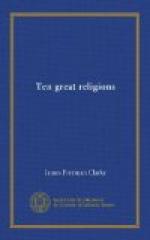Nor is anything known with certainty of the place where he lived or the events of his life. Most modern writers suppose that he resided in Bactria. Haug maintains that the language of the Zend books is Bactrian[130]. A highly mythological and fabulous life of Zoroaster, translated by Anquetil du Perron, called the Zartusht-Namah[131], describes him as going to Iran in his thirtieth year, spending twenty years in the desert, working miracles during ten years, and giving lessons of philosophy in Babylon, with Pythagoras as his pupil. All this is based on the theory (now proved to be false) of his living in the time of Darius. “The language of the Avesta,” says Max Muller, “is so much more primitive than the inscriptions of Darius, that many centuries must have passed between the two periods represented by these two strata of language[132].” These inscriptions are in the Achaemenian dialect, which is the Zend in a later stage of linguistic growth.
Sec. 5. Spirit of Zoroaster and of his Religion
It is not likely that Zoroaster ever saw Pythagoras or even Abraham. But though absolutely nothing is known of the events of his life, there is not the least doubt of his existence nor of his character. He has left the impress of his commanding genius on great regions, various races, and long periods of time. His religion, like that of the Buddha, is essentially a moral religion. Each of them was a revolt from the Pantheism of India, in the interest of morality, human freedom, and the progress of the race. They differ in this, that each takes hold of one side of morality, and lets go the opposite. Zoroaster bases his law on the eternal distinction between right and wrong; Sakya-muni, on the natural laws and their consequences, either good or evil. Zoroaster’s law is, therefore, the law of justice; Sakya-muni’s, the law of mercy. The one makes the supreme good to consist in truth, duty,




